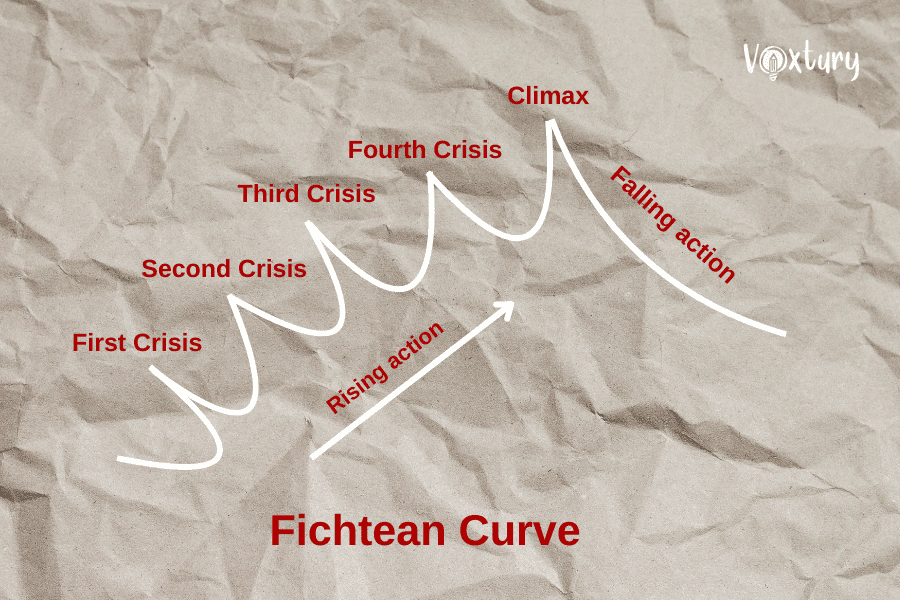We fall in love with stories that make us excited, glued to our screens and pages, that make our breaths quicker and nights shorter.
But how to write a truly engaging story? Well, one of the tools you can use to help you crack it is the Fichtean Curve. In this comprehensive guide, you will learn:
- What is the Fichtean Curve structure?
- Famous examples of this tool being used in literature and film.
- How to master this technique.
- And which genres benefit the most from this conflict-driven structure.
What Is the Fichtean Curve?
If you love stories that rush forward with little regard for broken bones and violet bruises, you’re going to appreciate the Fichtean Curve.
This narrative structure emphasizes a series of escalating crises, each driving the narrative forward and leading to the climax. It is named after the German philosopher Johann Gottlieb Fichte, who contributed to narrative theory by focusing on the importance of conflict and crisis in driving the development of a story.
The Fichtean Curve is a popular structure used in various genres, including thrillers, mysteries, and action-adventure stories.
It is particularly effective in creating suspense and keeping the reader engaged by constantly raising the stakes and pushing the characters to their limits.
Master the Art of Storytelling: Explore 7 Powerful Plot Structures
Discover the secrets behind captivating narratives with our comprehensive guide to 7 popular plot structures. From classic three-act structures to innovative nonlinear approaches, learn how to craft compelling stories that resonate with your audience.
Breaking Down the Key Elements of the Fichtean Curve
Let’s take a look at each stage of the Fichtean Curve, using Jaws as an example to illustrate how it works.

1. Inciting Incident
- The event that sets the story in motion and introduces the initial conflict.
- This is the protagonist’s first crisis, and it sets the stage for the rest of the story.
- The inciting incident should be something that forces the protagonist to make a choice or take action.
In Jaws, the inciting incident is the shark’s first attack, which kills a young woman and closes the beach. This event forces the police chief, Martin Brody, to confront his fear of the water and take action to protect his community.
2. Rising Action
- A series of crises that escalate in intensity, each one building on the previous one.
- These crises should be increasingly difficult for the protagonist to overcome, and they should raise the stakes with each passing moment.
- The rising action is where the protagonist’s character is developed and tested.
In our example, the rising action includes a series of shark attacks that terrorize the community and force Brody to take increasingly desperate measures to stop the shark. These attacks escalate in intensity, with each one bringing the shark closer to the town and putting more people at risk.
3. Climax
- The highest point of tension in the story, where the conflict reaches its peak.
- This is the moment when the protagonist must face their greatest challenge and make a final decision.
- The climax should be a satisfying resolution to the conflict, but it should also leave the reader feeling fulfilled.
In Jaws, the climax occurs when Brody, Hooper, and Quint confront the shark in its underwater lair. This is the moment of truth for Brody, as he must decide whether to fight the shark or flee.
4. Falling Action
- The resolution of the conflict and the tying up of loose ends.
- This is where the protagonist reflects on their experiences and learns from their mistakes.
- The falling action should provide a sense of closure and leave the reader satisfied with the story’s outcome.
The falling action occurs after the shark is killed. Brody and the other survivors return to their lives, but they are forever changed by their experiences. The film ends with a sense of closure, as the shark is defeated and the community is safe.
Examples of Stories Using the Fichtean Curve
Some famous examples of the Fichtean Curve being used in modern media?
- Inception: Directed by Christopher Nolan, this film begins with an immediate crisis as Dom Cobb is pursued in a dream world. The plot escalates through various layers of dreams and crises, reaching a climax during the final heist, followed by a resolution that leaves viewers questioning reality.
- Pulp Fiction: Quentin Tarantino’s film employs non-linear storytelling but effectively uses the Fichtean Curve within its segments. Each character faces escalating crises that lead to intense climaxes, followed by resolutions that intertwine their fates.
- Breaking Bad: This series exemplifies the Fichtean Curve as Walter White’s descent into the drug trade begins with an immediate crisis (his cancer diagnosis) and escalates through numerous conflicts and moral dilemmas, culminating in intense climaxes each season before resolving in dramatic fashion.
- A Confederacy of Dunces by John Kennedy Toole: This novel follows Ignatius J. Reilly as he navigates a series of misadventures in New Orleans. The rising action is filled with crises that reveal his character and the absurdity of his situation, leading to a chaotic climax.
As you can see, this story structure can be successfully utilized in various forms, including books, films, and TV series.

Why Use the Fichtean Curve?
At this point, you may have your own reasons as to why you’d choose the Fichtean Curve to base your story on. But, if you need more convincing, here are some of the key benefits of using this structure.
Constant Engagement
The Fichtean Curve is built on a foundation of escalating crises. This constant rise in tension keeps readers hooked, as they anticipate the next challenge the protagonist will face.
On top of that, by carefully pacing the introduction of new crises, authors can control the rhythm of the story, building suspense and excitement. If you’re writing a story where increasing the stakes is your priority, this narrative structure will be of great use to you.
Character Development
One thing we love more than seeing our characters thriving is to see them struggle. At least, some of us do. Most stories are based on this struggle and what comes of it.
Crises force characters to make difficult choices, revealing their deepest desires, fears, and motivations. As the stakes rise, characters are pushed to their limits, highlighting their strengths and exposing their vulnerabilities, which makes for an entertaining spectacle and gives you room as a writer to dig deep.
Genre Versatility
Like we said earlier, the Fichtean Curve is very versatile. Although it suits best genres that are particularly driven by suspense, like thrillers and mysteries, it can be adapted to a wide range of stories, including dramas, romances, and even comedies.
Craft Your Stories with Precision
As you delve deeper into the world of storytelling and explore the Fichtean Curve, ensure your words are as sharp as your narrative. Voxtury’s online Rich-Text Editor is your go-to tool for refining your writing. With its intuitive interface and powerful features like the duplicate word finder, you can polish your work to perfection.
Start crafting your next masterpiece today!
How to Use the Fichtean Curve
Now that you know why exactly this narrative tool can be beneficial to your work, it’s high time to learn how to master the Fichtean Curve.
Hook Your Reader
In this structure, there’s no time like the present. Your opening should include a gripping event that immediately captures the reader’s attention. This could be anything from a shocking revelation, or a dangerous encounter, to a life-altering decision. Don’t forget to:
- Introduce a relatable and compelling protagonist whose goals and desires drive the narrative.
- Present a clear and immediate conflict that challenges the protagonist and sets the stage for the story’s central struggle.
Integrate Backstory and World-Building
Remember—pacing is everything in this type of story. You don’t want to bore your readers with long and convoluted world descriptions.
Incorporate world-building details organically into the narrative, revealing them through dialogue, action, or description. Be mindful not to do it all at once but only when it makes the most sense.
Maintain a Fast-Paced Narrative
But how?
- Break down the story into concise chapters to keep the pace brisk and engaging.
- Use dialogue to advance the plot, reveal character motivations, and create tension.
- Employ active voice and vivid verbs to create a sense of urgency and excitement.
Craft a Powerful Climax and Resolution
This one is particularly crucial. The climax should be a culmination of the rising action, with the protagonist facing their greatest challenge. This means the stakes need to be big enough for the whole story to be impactful.
The Fichtean Curve is very useful in creating those stakes since you raise them the further you go. So, start smaller and add on the stakes gradually to build the climax.
Pro Tip
If you’re a visual learner, try to use our Fichtean Curve diagram to represent your rising conflicts on a page. Note that each new complication needs to be more significant than the last one. The climax of the story is where the most important hurdle is removed.
When to Use the Fichtean Curve
Okay, so we talked a bit about why and how to utilize the Fichtean Curve, but what about when? Is the Fichtean Curve a good tool for any type of story?
The Fichtean Curve is particularly well-suited for several genres and formats:
Thrillers and Action Stories
- Sustained Tension: The constant escalation of crises keeps readers on the edge of their seats, heightening suspense and tension.
- Pacing: The rapid progression of events maintains a fast-paced narrative, mirroring the adrenaline-fueled nature of these genres.
- Climatic Showdowns: The Fichtean Curve naturally leads to explosive climaxes, where the protagonist faces their ultimate challenge.
Character-Driven Dramas
- Character Development: The series of crises can reveal the character’s depth, motivations, and vulnerabilities.
- Emotional Impact: The escalating stakes and personal sacrifices can evoke strong emotional responses from readers.
- Transformation: The protagonist’s journey through these trials can lead to significant personal growth and transformation.
Shorter Narratives
- Immediate Engagement: The rapid introduction of conflict and rising stakes quickly draws readers in.
- Concise Storytelling: The focused structure of the Fichtean Curve is ideal for short stories, novellas, or one-shot scripts.
- Satisfying Resolution: The climax and resolution can be condensed into a powerful and impactful ending.

These are some of the types of stories that can benefit from The Fichtean Curve, but you’re not limited in how you utilize the structure in your writing. As long as it helps you achieve intended results, you can freely use the Curve to help you craft magical and fast-paced romances or mysterious adventures. As we like to say, the world is your oyster!
Final Thoughts
The Fichtean Curve, a narrative structure centered around escalating crises, is a powerful tool for keeping readers engaged.
By embracing this approach, you can elevate your storytelling and deliver unforgettable reading experiences.
Hungry for more? Check out Voxtury’s book writing tips and insights and become the writer you’ve always dreamed of being! We’re honored to support you in your journey!